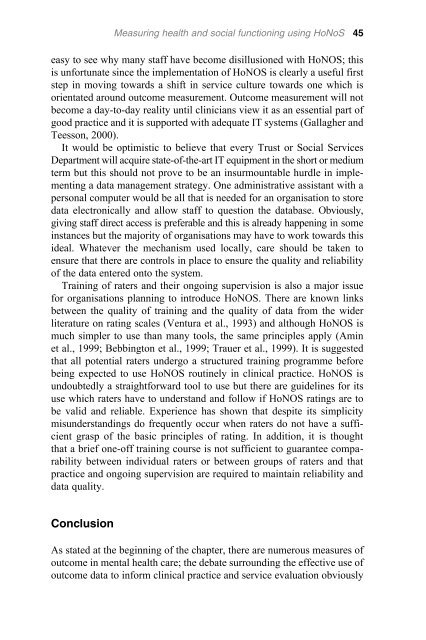Mental Health Nursing
Mental Health Nursing
Mental Health Nursing
You also want an ePaper? Increase the reach of your titles
YUMPU automatically turns print PDFs into web optimized ePapers that Google loves.
easy to see why many staff have become disillusioned with HoNOS; this<br />
is unfortunate since the implementation of HoNOS is clearly a useful first<br />
step in moving towards a shift in service culture towards one which is<br />
orientated around outcome measurement. Outcome measurement will not<br />
become a day-to-day reality until clinicians view it as an essential part of<br />
good practice and it is supported with adequate IT systems (Gallagher and<br />
Teesson, 2000).<br />
It would be optimistic to believe that every Trust or Social Services<br />
Department will acquire state-of-the-art IT equipment in the short or medium<br />
term but this should not prove to be an insurmountable hurdle in implementing<br />
a data management strategy. One administrative assistant with a<br />
personal computer would be all that is needed for an organisation to store<br />
data electronically and allow staff to question the database. Obviously,<br />
giving staff direct access is preferable and this is already happening in some<br />
instances but the majority of organisations may have to work towards this<br />
ideal. Whatever the mechanism used locally, care should be taken to<br />
ensure that there are controls in place to ensure the quality and reliability<br />
of the data entered onto the system.<br />
Training of raters and their ongoing supervision is also a major issue<br />
for organisations planning to introduce HoNOS. There are known links<br />
between the quality of training and the quality of data from the wider<br />
literature on rating scales (Ventura et al., 1993) and although HoNOS is<br />
much simpler to use than many tools, the same principles apply (Amin<br />
et al., 1999; Bebbington et al., 1999; Trauer et al., 1999). It is suggested<br />
that all potential raters undergo a structured training programme before<br />
being expected to use HoNOS routinely in clinical practice. HoNOS is<br />
undoubtedly a straightforward tool to use but there are guidelines for its<br />
use which raters have to understand and follow if HoNOS ratings are to<br />
be valid and reliable. Experience has shown that despite its simplicity<br />
misunderstandings do frequently occur when raters do not have a sufficient<br />
grasp of the basic principles of rating. In addition, it is thought<br />
that a brief one-off training course is not sufficient to guarantee comparability<br />
between individual raters or between groups of raters and that<br />
practice and ongoing supervision are required to maintain reliability and<br />
data quality.<br />
Conclusion<br />
Measuring health and social functioning using HoNoS 45<br />
As stated at the beginning of the chapter, there are numerous measures of<br />
outcome in mental health care; the debate surrounding the effective use of<br />
outcome data to inform clinical practice and service evaluation obviously
















